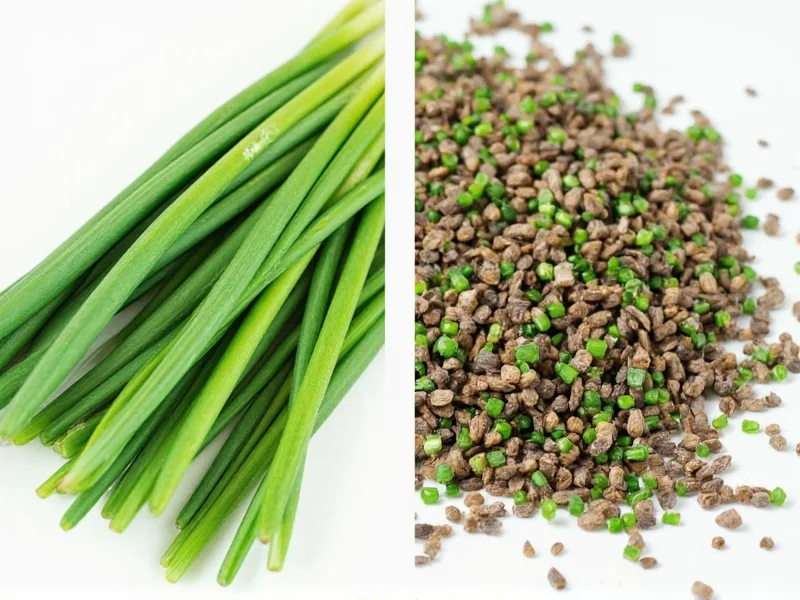Understanding the differences between fresh chives vs dried chives is essential for maximizing flavor in your cooking. While both come from the same plant (Allium schoenoprasum), their preparation methods create distinct culinary properties that affect taste, texture, and application in recipes.
Flavor Profile Comparison
Fresh chives provide a bright, grassy onion flavor with subtle garlic notes and a crisp texture. The flavor is delicate enough to use raw as a garnish without overwhelming other ingredients. Dried chives undergo dehydration that concentrates certain compounds while diminishing others, resulting in a more muted onion flavor with earthier undertones. The drying process removes the fresh grassiness, leaving a one-dimensional onion taste that lacks complexity.
When evaluating fresh chives vs dried chives flavor difference, professional chefs note that fresh chives contain volatile sulfur compounds that dissipate during cooking, making them ideal for finishing dishes. Dried chives have stabilized compounds that withstand heat better but never deliver the same aromatic complexity as fresh.
Texture and Visual Differences
The textural contrast between fresh and dried chives significantly impacts dish presentation. Fresh chives maintain their cylindrical shape when properly chopped, adding vibrant green specks and slight crunch to finished dishes. Dried chives appear as dark green to brownish flakes that rehydrate partially but never regain their original structure, often creating a speckled appearance that some find unappealing in delicate dishes.
| Characteristic | Fresh Chives | Dried Chives |
|---|---|---|
| Flavor intensity | Delicate, grassy onion | Muted, one-dimensional |
| Texture | Crisp, cylindrical | Flaky, brittle |
| Color | Bright green | Olive green to brown |
| Shelf life | 1-2 weeks refrigerated | 6-12 months stored properly |
| Best culinary use | Finishing garnish | Cooking into dishes |
Nutritional Comparison
Nutritionally, fresh chives contain higher levels of vitamin C, vitamin K, and allicin (the compound responsible for many onion-family health benefits) compared to their dried counterparts. The dehydration process preserves some nutrients but reduces others, particularly water-soluble vitamins. Fresh chives provide approximately 30% more vitamin C per serving than dried chives. However, dried chives offer more concentrated minerals per volume since water content has been removed.
Practical Substitution Guidelines
When substituting dried chives for fresh in recipes, understanding the proper fresh chives dried chives substitution ratio prevents flavor imbalances. The standard conversion is:
- 1 tablespoon fresh chives = 1 teaspoon dried chives
- 3 tablespoons fresh chives = 1 tablespoon dried chives
For best results when using dried chives, rehydrate them in a small amount of warm water or broth for 10-15 minutes before adding to dishes. This improves texture and distributes flavor more evenly. When substituting dried for fresh in uncooked applications like dips or salad dressings, use half the recommended amount since the flavor won't mellow during cooking.
Optimal Culinary Applications
Certain dishes benefit specifically from one form over the other. Understanding when to use dried chives instead of fresh ensures optimal results:
Best uses for fresh chives:
- As a finishing garnish for soups, baked potatoes, and omelets
- In uncooked applications like salad dressings and dips
- With delicate dishes where subtle onion flavor is desired
- In compound butters and herb creams
Best uses for dried chives:
- In baked goods like savory scones and breads
- When cooking dishes for extended periods (stews, casseroles)
- In spice blends and dry rubs
- When fresh chives aren't available but onion flavor is needed
Storage Recommendations
Proper storage maximizes the shelf life of both forms. Store fresh chives wrapped in a slightly damp paper towel inside a perforated plastic bag in the refrigerator crisper drawer. This method typically preserves freshness for 10-14 days. For longer storage, freeze fresh chives by chopping and placing in ice cube trays with water or oil.
Dried chives maintain best quality when stored in an airtight container away from light, heat, and moisture. Properly stored, dried chives retain optimal flavor for 6-12 months. Check dried chives periodically for color and aroma; if they've turned brown or lost their scent, they've likely lost most flavor value.
Cost and Availability Considerations
Fresh chives typically cost more per ounce than dried but offer superior flavor. A small bunch of fresh chives (about 1 ounce) costs approximately $1.50-$2.50 at most grocery stores, while an equivalent flavor amount in dried form costs about $0.25-$0.50. However, the superior flavor profile of fresh chives often justifies the higher cost for discerning cooks.
Availability varies by season and location. Fresh chives are most abundant and affordable in spring and early summer but available year-round in most supermarkets. Dried chives maintain consistent availability but quality can vary significantly between brands, making it worth seeking reputable spice suppliers when purchasing.
Common Mistakes to Avoid
Cooks often make these errors when working with fresh chives vs dried chives:
- Using equal volumes when substituting (dried is more concentrated)
- Adding fresh chives too early in cooking (heat destroys delicate flavor)
- Using dried chives in raw applications without rehydrating
- Storing dried chives in clear containers (light degrades quality)
- Chopping fresh chives with a dull knife (bruising affects flavor)











 浙公网安备
33010002000092号
浙公网安备
33010002000092号 浙B2-20120091-4
浙B2-20120091-4